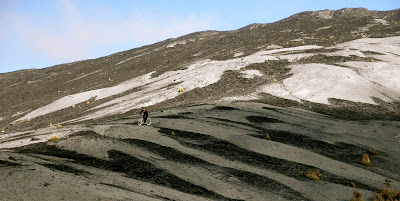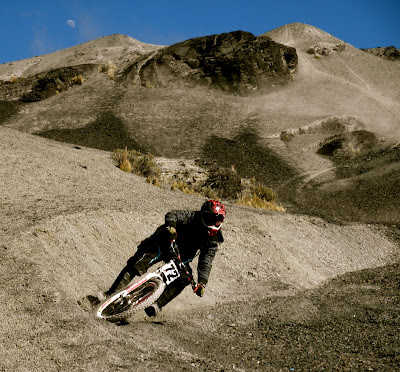
Leaving La Paz there's a route that goes up some near vertical streets of the upper neighborhoods before popping out through a side canyon to a plateau that slopes up to the Cordillera. A swooping two track climbs up, at times right on the top of a knife-ridge until you arrive to the reservoir that serves La Paz with its water supply. This is now getting into the zone above the last grassy vegetation, the barren summits that dish out a full serving of velvety scree.


Mauricio Jordan, chief of Moto Epix, demonstrates roosting


up...
down...
...and sideways.






On this day we continued down the death road to Yolosa, continuing on to Mauricio's property between Coroico and Caranavi. He has a sweet zipline strung up there. After checking in on the place, we rallyed back to Coroico. The annual music festival was happening, so finding accomodations was tough. Fortunately we were able to crash on the floor in the ping pong room of a hostal. The plaza was packed with Paceños, blasting the musica from their cars, dancing and boozing it up. A sizable contingent of policias looked on from the station steps. Apparently there are no open container or public drunkeness restrictions down here.
The next morning our plans of an early start were thwarted in the parking garage by a couple of cars with passed out owners inside, blocking the exit. It was 10:30 by the time they were revived and we were able to get the bikes out onto the street. We continued on our mission, to cross over from the Nor Yungas to the Sur Yungas via the 'ruta de la coca' to Chulumani, then continue to Plazuela and the 2 track jeep road that climbs up to the pass between Illimani and Mururata, and down to La Paz.
First we came to Coripata, a funky village where the bike of choice is WWII era Jawas. I counted 14 parked around the plaza. The cocaleros weld up a big rack for the back to carry massive sacks of coca leaf.

We continued along the seldom traveled road, though coca plantations and semi-arid ridges before dropping down to the green river and the Sur Yungas road that traverses its course before climbing up to Chulumani. After a quick lunch we were on our way to the tranquil town of Irupana, in the tropics at the base of the Illimani massif.

From here the road descends to the canyon floor of the Rio La Paz. We took a turnoff and began to climb, from 1300 m elevation up to the 4,600 m pass, as fast as we could because the day was waning.
Up and up we went, passing the ancient tiwanaku terraces of the Pasto Grande site. As we ascended we reached the cloud level, the vegetation changed from desert scrub to a lush bonzai forest, dripping with lichens, the snowy heights of Illimani rising above the clouds. After about 4 hours of pinning it up the two track we crested the pass, between snowy peaks and gold mines, and began the descent into the Palca Canyon, through the narrows and back to La Paz.



















































